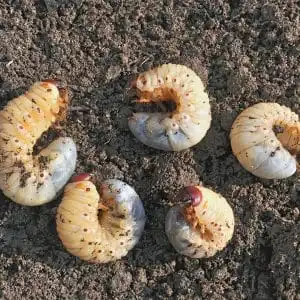Identifying Grubs and the Damage They Do
Signs of grub damage are spongy turf, excess weeds, brown or yellow patches of grass, and dead or dying plants. How do the pests do it? They feed on grass and plant roots, cutting off the supply of needed nutrients and water. But since grubs do their dirty work underground, it’s hard to know if you have an issue.
Not sure if you have a problem? Try the turf test by grabbing a handful of grass. Gently tug it, and if it peels back easily like a loose rug, the root system is significantly damaged. And you’ll see the small, whitish, fat worm-like creatures underneath. They curl up as soon as their home turf is disturbed.
Fortunately, spotting just a few grubs is okay. But when the population grows, even the healthiest lawns can’t survive an infestation. Try using do-it-yourself remedies for grubs as soon as you suspect a problem.
Do-It-Yourself Remedies for Grubs
A healthy, well-maintained lawn is usually strong enough to survive a small amount of grubs. But even if you water, fertilize, and mow your turf regularly, it may not be immune to an infestation. Here are some tips and do-it-yourself remedies for grubs to get you going.
- Be sure not to overwater as a moist environment is ideal for beetles to lay eggs.
- Plant grasses with deep root systems. Shorter grass roots sustain damage quicker than long roots, which require less water and can survive minor amounts of damage from pest feeding frenzies. Tall fescue is a type of grass that has a substantial root system.
- Purchase milky spore disease powder at your local garden store. The environmentally safe fungus is easily applied by sprinkling the powder form over infected areas. This remedy is win-win because it kills the grubs and then the spores spread to prevent future infestations.
- Add water to laundry detergent and pour the mixture on the infected areas. Once it soaks into the ground, grubs come to the surface. Above the soil, they are in reach for birds and small animals to eat them. This also makes them prime for plucking by hand, if you choose to take on that task.
- Use neem oil as a repellant for Japanese beetles and their larvae. Mix it with water and spray this botanical pesticide on infected areas.
- Bring on the beneficial nematodes to fight grubs, and even some other pests, naturally. These microscopic parasites feed on grub larvae yet won’t attack plants and grasses. They are available at many garden stores and are easy to apply. Just make sure to water the lawn before and after application. This ensures that they soak down into the soil.
If all else fails, call in a professional. They know what pest control products work best and how to use them properly. Contact Free Spray Lawn Care today at 419-529-5296 and we’ll help you prevent pests from taking over your lawn.



Comments (0)
Thanks for your comment!
Thanks for your feedback! Your comments have been successfully submitted! Please note, all comments require admin approval prior to display.
Error submitting comment!
There is a problem with your comment, please see below and try again.